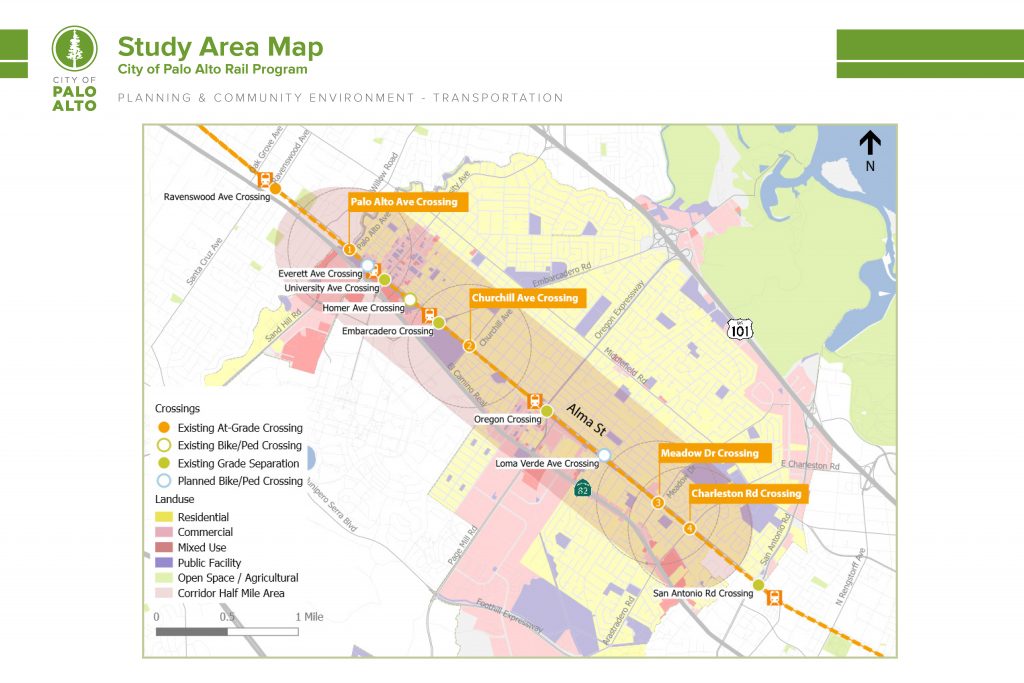What is Connecting Palo Alto?
Connecting Palo Alto is a community-based process to address the increased traffic congestion expected when Caltrain electrifies the tracks and runs more trains through the corridor. Community feedback and collaboration are a vital part of this decision-making process that will affect future generations to come.
The Role of City Council
Please visit Decision Making by City Council for information, including dates of Council meetings with rail grade separation as a topic.
The XCAP Final Report for City Council is available on the Reports page. The report was completed on March 4, 2021.
Quick access to popular pages
Virtual Town Hall
The Connecting Palo Alto Virtual Town Hall was an interactive digital forum and exhibit, designed to engage and inform the community on rail crossing alternatives. The Virtual Town Hall ran from August 19, 2020 through September 14, 2020. There were two Virtual Town Hall Q&A Sessions. Here are the August 27, 2020 Q&A Session Materials and the September 3, 2020 Q&A Session Materials.
XCAP Meetings:
Please visit the XCAP meetings web page to see meeting dates and meeting materials (agendas, summaries, videos, etc).
The Stay on Track blog series:
August 18, 2020 – Stay on Track Blog Series: Community Conversations Phase Continues with New Virtual Town Hall Experience
December 18, 2019 – Stay On Track Blog Series: Materials and Information Available to Help the Community Join the Conversation
November 27, 2019 – Stay On Track Blog Series: Recap of the November 7 Rail Community Meeting, Online Comment Card Available, and New Ways to Join the Conversation Coming Soon
Why is this important?
Who decides?
How is the community involved?
What alternatives are still on the table?




Why is this important?
For over 150 years, Palo Alto has enjoyed regional connections to San Francisco and San Jose via rail. Now known as the Caltrain corridor, it is used by thousands of daily commuters from Gilroy to San Francisco. While it is a convenient connection to the larger Bay Area, today’s rail is a physical constraint to east-west movement in Palo Alto. The current grade crossings create some traffic congestion and pose safety and noise challenges that will worsen as the frequency of train service increases with the modernization of Caltrain’s fleet of trains going from diesel to electric trains. As a result, the City is actively doing long-term planning for the rail corridor to improve east-west connectivity for generations to come.
There are currently six streets where people can cross the railroad tracks in Palo Alto. Two of these intersections, called grade crossings, are above the road and already grade separated, but the other four cross the tracks at the same level. Traffic congestion is expected to increase at all four of these locations as Caltrain begins to use electric trains and run more frequent trains. This will mean that crossing gates will come down as frequently as every 45 seconds to 3 minutes during peak hours impacting traffic and safety.
A plan is needed to help Connecting Palo Alto and keep traffic moving.
What are the challenges?
Finding a solution that the community can support, identifying funding sources for construction, and obtaining regulatory approvals are just a few of the challenges.
Who decides?
City Council is the final decision maker for this project for a preferred rail grade separation for Palo Alto’s rail crossings. Council receives input from the community, from City staff, and from key stakeholders, and makes decisions based on this input.
Once the preferred rail grade separation alternatives are selected by City Council and confirmed by Caltrain, City staff will follow steps needed to implement them.
How is the community involved?
Connecting Palo Alto is a community-based process. The community is involved in every step of the way.
The Expanded Community Advisory Panel (XCAP) is a panel of Palo Alto residents who evaluate information related to grade crossing alternatives and make recommendations to the City Council.
What alternatives are still on the table?
Please visit the Renderings, Plans, and Animations web page to see alternatives.

Sign up for our mailing list: